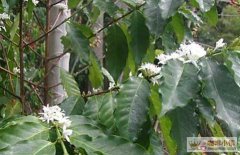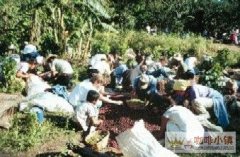The growing period of picking coffee beans.

After 3 or 4 years of growth, the coffee tree matures and begins to bear fruit, and the fruit will be arranged in clusters or clustered together along the branches. The coffee beans we see are the seeds of the coffee tree. The outside of the seed is a layer of pericarp, with the maturity of coffee beans, the pericarp will change from green to red, as soon as it turns red, it can be harvested. The structure of coffee fruit is usually a layer of pulp (mesocarp) under the exocarp, a small thin layer inside, and then a layer of parchment-like substance-endocarp. In all of these peels, there are usually two beans with opposite planes, and the beans have a thin film or skin on the outside.
The maturity of most Arabica coffee beans is 6-8 months, while that of Robbins specialty coffee beans is 9-11 months.

The harvest time is also different in different regions, and the north of the equator is generally harvested from September to November. The main one south of the equator is in April or May, but it can last until August. Countries in some equatorial regions can harvest throughout the year. So you can have new coffee beans for most of the year.
There are usually two ways to pick coffee. One is picking in pieces, that is, picking without choice, which can also be picked mechanically if conditions permit. The other is selective picking, which has a large amount of labor and high picking cost. it is generally only used in Arabica species, especially in washing Arabica coffee beans.
Important Notice :
前街咖啡 FrontStreet Coffee has moved to new addredd:
FrontStreet Coffee Address: 315,Donghua East Road,GuangZhou
Tel:020 38364473
- Prev

Coffee species Coffee Tree species basic knowledge of Fine Coffee
Coffee is called coffea in the biological genus. The genus is a member of the Rubiaceae family. It has more than 500 species and more than 6000 species, most of which are tropical trees and shrubs. From the point of view of drinkers, coffee trees can be roughly divided into five types, of which Arabica and Robusta are more common. Arabica species account for 70% of the world's total output.
- Next

Basic knowledge of fine coffee processing methods of raw coffee beans
Raw beans generally use washing and drying methods, both of which can produce high quality raw beans. First, washing method: generally speaking, there will be more distinct acidity and more consistent flavor. In the process of washing, the pulp is immediately separated from the raw bean, rather than drying it. The steps are as follows: 1. Selection: put the fruit in the sink and let stand for about 24 hours. Mature and immature due to
Related
- Beginners will see the "Coffee pull flower" guide!
- What is the difference between ice blog purified milk and ordinary milk coffee?
- Why is the Philippines the largest producer of crops in Liberia?
- For coffee extraction, should the fine powder be retained?
- How does extracted espresso fill pressed powder? How much strength does it take to press the powder?
- How to make jasmine cold extract coffee? Is the jasmine + latte good?
- Will this little toy really make the coffee taste better? How does Lily Drip affect coffee extraction?
- Will the action of slapping the filter cup also affect coffee extraction?
- What's the difference between powder-to-water ratio and powder-to-liquid ratio?
- What is the Ethiopian local species? What does it have to do with Heirloom native species?

